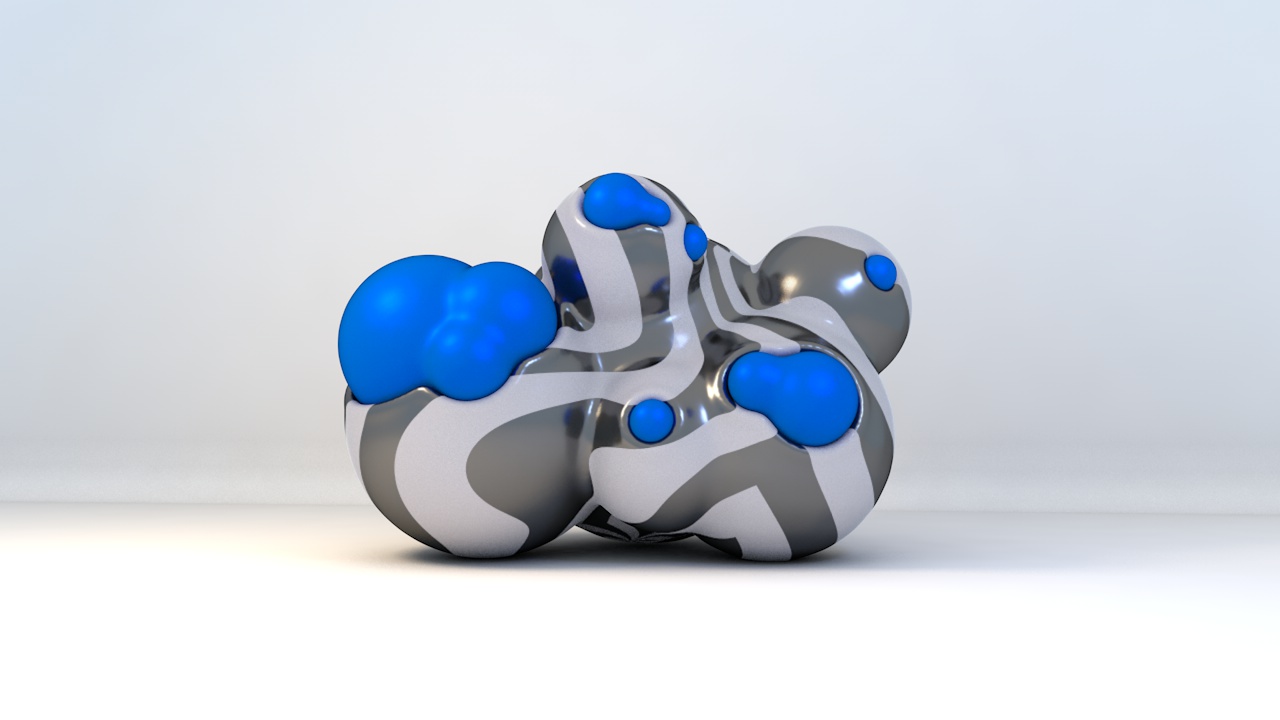-
Posts
2,052 -
Joined
-
Last visited
-
Days Won
119
Content Type
Profiles
Blogs
Forums
Gallery
Pipeline Tools
3D Wiki
Plugin List
Store
Downloads
Everything posted by HappyPolygon
-
The neat free web app, created by industrial designer – and former Weta Workshop senior 3D modeller – Jorge Valle lets you create custom checker maps, and download them at up to 8K resolution for free. UV Checker Map Maker lets you customise pretty much any aspect of a checker map, including the size of the grid and microgrid, the numbering convention (letters and numbers or coordinates), and the colours. Settings are controlled via radio buttons or on-screen sliders, and there are nice usability options like the one to have the colour of the text change automatically with that of the background for maximum legibility. Once created, you can download the checker map at resolutions between 1,024 x 1,024px and 8,192 x 8,192px in PNG format. http://uvchecker.byvalle.com/
-

How to make a generic form polygonal closed curve in Cinema 4d
HappyPolygon replied to Eudes Fileti's topic in Cinema 4D
If you right-click on a custom spline's point you can set a smooth interpolation. If your spline is of linear type (like the rectangle primitive spline) changing a hard interpolation to smooth will automatically change it to Bezier. -
I think that scene was made using Vertex Maps all over. Even the logo is a vertex map. I think it's a blend between the logo and a voronoi noise. The vertex map wasn't only used to influence the inflation but also the stiffness.
-

How to make a generic form polygonal closed curve in Cinema 4d
HappyPolygon replied to Eudes Fileti's topic in Cinema 4D
I agree with Cerbera. It can also be done using a Spline Wrap do avoid too much geometry. dashed lines.c4d But I think the most straight-forward solution would be Sketch & Toon -

Falloff-based selection of clones... is it even possible?
HappyPolygon replied to JustinLeduc's topic in Cinema 4D
Oh... well that raised the difficulty bar to new heights ... Yes you do need a ray-cast. A bunch of splines casting towards a direction until they hit something. Make them all line-up linearly and use them as a field. It definitely can be done with Scene Nodes, not in S22. Maybe ricochet can do that for you. -

Falloff-based selection of clones... is it even possible?
HappyPolygon replied to JustinLeduc's topic in Cinema 4D
What you're asking for is a 2D Camera Projection Falloff. I've suggested something like this in the past. It involved SceneNodes. Since there isn't something like that implemented you'll need to construct it yourself. The camera's frustum is a pyramid so with this in mind I constructed a field that is a child of the camera to be on par with it. Note that I'm working in R20 and the Use Fields in the MoGraph Selection hadn't been implemented at that time, so I tried to affect clones directly. You can add them later. Unfortunately there is no Pyramid Field, so I used a Pyramid object as a Point Object Field. Well that didn't work either because the Invert Layer Effect apparently does not apply to generic Point Object Field. I don't know if this has been resolved in later C4D versions. So I had to be more creative. I don't use Octane, I'm not sure how much that will affect your project. Use the From parameters in both Tubes to affect as many rows or columns you like from the camera's point of view. Affecting objects from camera.c4d -
This is awesome MighT ! Also happy to see you around. Your SeneNodes approach worths mentioning on a old scenenodes post.
-
You can't change the simulation bounding box (green). C4D uses a sparse voxel tree for the simulations. This means it will generate as many voxels in the 3D space as it needs to depict the simulation until it runs out of VRAM in which case you will get a waring message. This voxel tree has no bounds, so the green box will expand as needed. Turbulence4D AFAIK has a constant user defined simulation bounding box that prevents any simulation taking place out of it. What you can change is the Padding. These are yellow voxels and you can view them from the Pyro object->Pyro tab or Project -> Pyro. Padding is a reserved layer of voxels around the "core" simulation as a "safety" net to catch any simulation data that may exceed the occupied simulation. It's like having reserved simulation space because you can't predict exactly how far the simulation will spread. If you don't see nice edges of smoke increase the Padding by one, If you're talking about the banding, making smoke look like marble, remember that what you see in the Viewport is a representation of the actual simulation. If you don't see that banding in rendering you don't have to worry about it.
-
Nvidia has announced its latest updates to Omniverse, its real-time 3D design collaboration platform. Highlights include a new version of the Omniverse-compatible version of Blender that adds ‘one-button’ integration with Audio2Face, Nvidia’s free AI-based tool for generating facial animation from audio. Nvidia also announced that Canvas, its free AI-based painting tool, will be added to the Omniverse Launcher, and posted a teaser video for the next release. The update – available later this quarter – will make it possible to generate 360-degree images suitable for use as environments in 3D scenes, as well as conventional 2D images. 230104_OmniverseJanuary2023Updates_Canvas.mp4
-
I think your implementation describes a special Modrian Tilling method with only squares. It's actually a rectangle packing algorithm ! mondrian.c4d
-
That's how I like my cheese... Apollonian ... 😆
-
Wow ! Hard to figure out how you did that. Looks like a sky animation used in the reflection channel of a torus. But the symmetry of the stars breaks after a while from clouds as if the were mapped differently from the rest of the sky. Well done.
-

"Machines for Creators" - Hardware YouTube-Reviews
HappyPolygon replied to renderbaron's topic in Discussions
What does the ECC stand for ? (when talking about GPU Ram) -
@Daniel Seebacher i've been using Vue for a long time but I need to know for sure. (vue 2016) When I use Vue as a plugin in C4D is it true that I can render a Vue scene using the native renderer of C4D or did I misunderstood that from the manual ? One more thing before the new release... Please design (well, not you, the team, you know) some nice icons for the Vue scene objects in the C4D object manager. Those gray squares look so broken...
-
Thank you Sharpears
-
In the first attempt in screenshot I thought it created point-like circles. I had in mind something like this guy did here. Which doesn't seem to be too heavy. But it also lacks the recursive inflation of the circles... It kinda bugs me that the AI creates flawless Blender code but again maybe I should reconsider how I ask it to do things, like this guy here did using explicit function names in his queries.
-
My spark for environmental modeling was always Magic the Gathering Land cards. Unfortunately I don't possess and probably never will the amount of RAM needed to populate my environment with the appropriate amount of foliage and flora...
-
It's OK. I think it's not the first time E-on skips a year before releasing the next major version.
-
Oh they have a phrase to describe Putin... That's weird, shouldn't the compiler throw a library call error to that like "no SPLINETYPE_LINE class/attribute/function call found in module c4d" though ? I didn't get an error. Great post SHARPEARS this is how one can start learning C4D python. Not just with examples but also counter-examples and side-notes explaining the reason it is done as it is and not the other way. I guess this is my training model. The so called "hands-on real-problem solving" method or "project-based". As for the rest of the algorithm, for which I am tapping my feet with excitement to see, I have two ideas of how the algorithm should go...
-
No, still waiting for it ! I checked yesterday. How are they supposed to name the new release 2022 if it's released in 2023 ...
-
I think this behavior was either hard coded to the AI or an inevitable side-effect. And this is reflected in this answer. So it's purpose is to assist and nothing more. And it is coded to recognize as the only goal this assistance. It has been trained in this huge yet limited pool of knowledge and released to assist based on that knowledge. So from the AIs' point of view it assumes that what ever is being asked can be answered with the provided base knowledge pool. Because that was the reason for the developers to make it. So when it answers it does it with a sense of complete authority and all-knowingness because that's how it was designed. It was designed to assist, that implies an act of competence not doubtfulness. It wasn't design to question the training knowledge or contemplate if the answer given was wrong as a self-validation/improvement step (maybe that would lead to an endless feedback loop or eventually always end to a "I don't have enough data to answer correctly" type of response). The developers gave it the ability to remember previous parts of the conversation in order to be able to stay on topic without derailing and that also meant that the user could also point out logical inherences made from AI. So re-feeding the answer to the AI can improve the answer to a point and of course if there is a logic cornering the AI will apologize. I guess it has some deductive logic in order to make new knowledge not explicitly expressed in the training knowledge in order to answer questions in a more general/abstract way but it sill fails to "see" and use information as we do. You could say it's an 8-year-old child that has read everything including the Oxford dictionary in order to hold interesting conversations but it lacks the experience of connecting input information in the right way with the base training knowledge. In other words logic to lead to wisdom. I've seen some funny memes depicting exactly that king of inability But it has great language skills Mathematics and programming are closely related as both contain logic. Most people are not good in math and logic. Language was the first great intelligence step, then writing and then mathematics. I guess it will be the same with AI too.
-
You're a living CG encyclopedia Fritz. I wish I had a professor like you. Happy new year.
-
Sorry for any misunderstanding. The VRAM I was referring was the OS technique of temporarily transferring data from random access memory (RAM) to disk storage. The OS VRAM can be expanded but the GPU RAM cannot. This is probably what JAEE also thought. Does that mean that all VDB elements (imported and internally generated) although stored in HD cannot be used partially (specific frame at a time) unless fully loaded exclusively to the GPU VRAM ? Is there any trick to make it load them in the usual RAM (or not at all but still be part of the project file and retrieve only the essential frame for rendering) like disabling any previews or using XRef ?
-
I'm afraid not. If you open the Task Manager and see the graphs of the Performance tab reach the ceiling there isn't anything you can do. Pyro probably doesn't use VRAM but the GPU RAM. Fritz is the technical expert here and suggested exporting to VDB.

